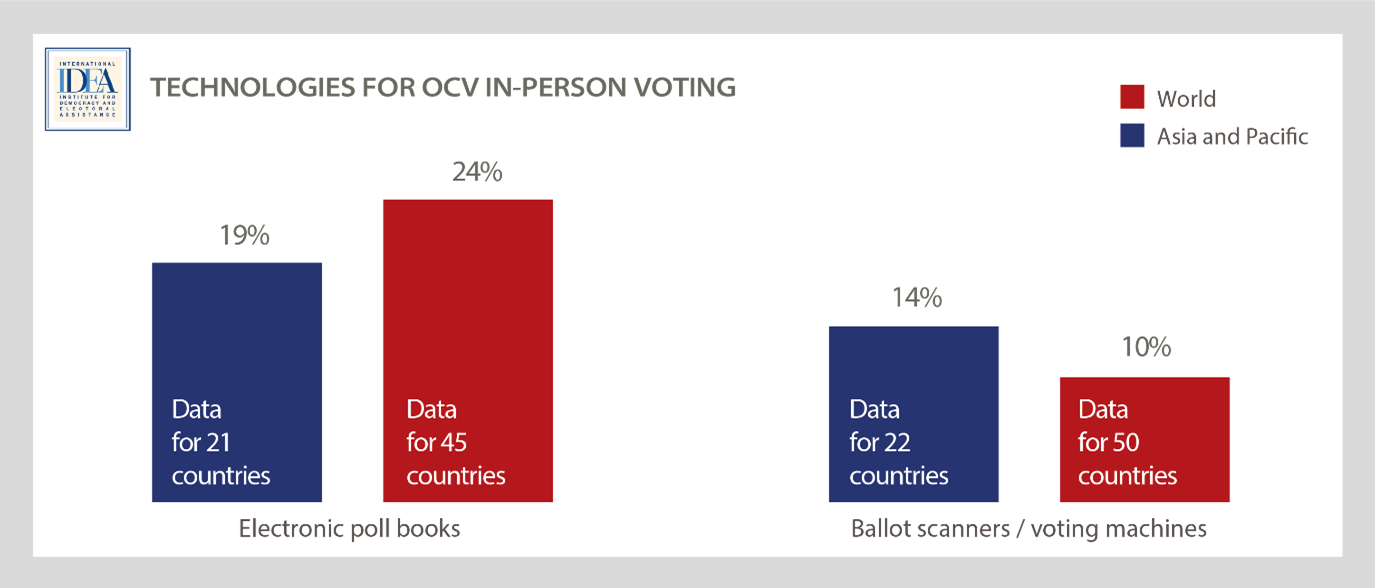Unravelling Out-of-Country Voting
A Deeper Look into OCV Practices, the Use of Technology and Turnout
Introduction
The dataset has been developed using data from two independent surveys: in the first survey, Out-of-Country Voting(OCV) Practices and Use of Technology data have been collected from 62 countries, and in the second survey, OCV Turnout data have been collected from 98 countries (see Figure 1). There were 49 overlapping countries in both of these surveys. Therefore, the joint analyses presented in Part 3 are based on those 49 countries.
Figure 1: Countries covered by the surveys
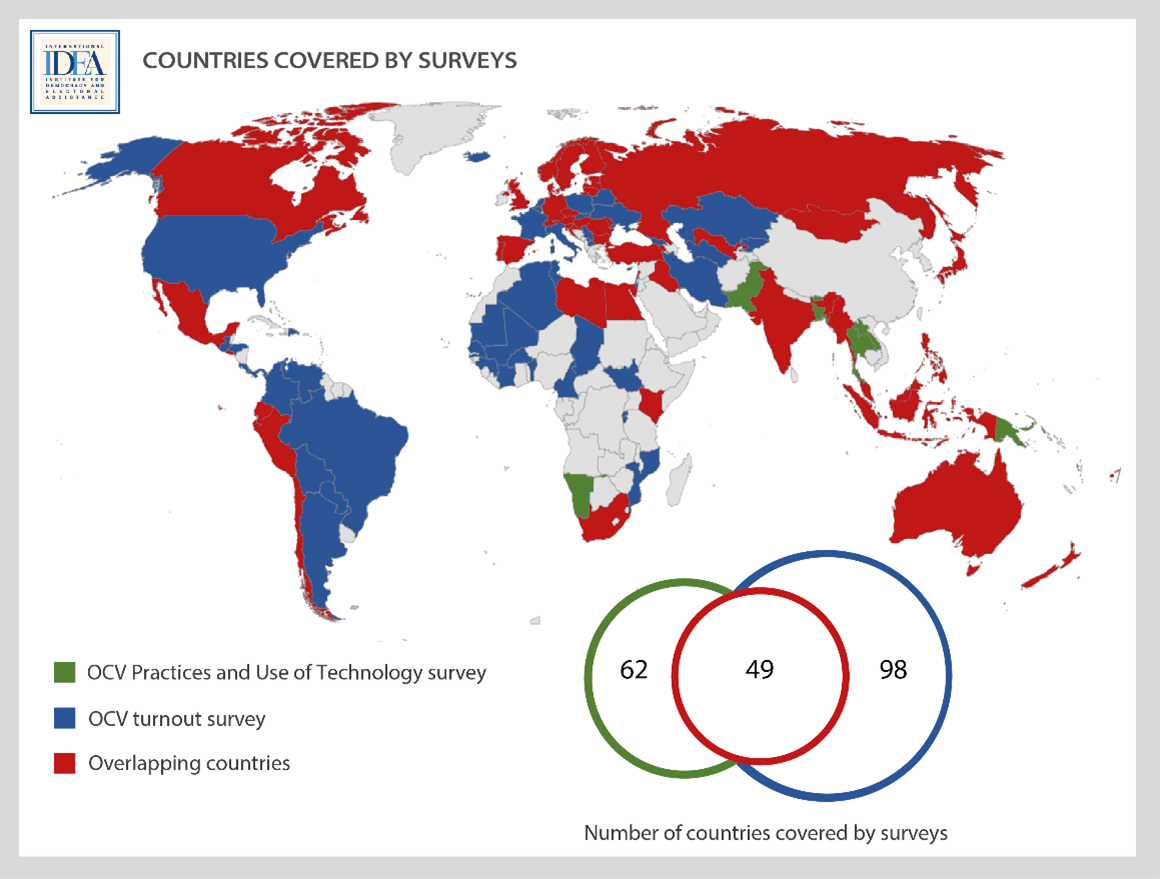
PART 1: OCV PRACTICES AND USE OF TECHNOLOGY
PART 2: OCV TURNOUT
PART 3: THE IMPACT OF OCV PRACTICES ON OCV PARTICIPATION RATES
PART 4: COMPARING ASIA & THE PACIFIC REGION WITH THE REST OF THE WORLD
Methodology
Data for both surveys have been collected in 2022 largely by International IDEA’s own research efforts. For the OCV Practices and Use of Technology survey, a specific questionnaire has been developed and sent out to EMBs. Since the response was low, additional research has been conducted targeting regulations and legislation providing for elections and also secondary sources, such as election observation mission (EOM) reports, publications available in EMB websites, and other reliable sources. The OCV Turnout data were obtained mainly from the official publications of EMBs or direct contacts with EMBs, and only in few cases, when EMB reports were not available, secondary sources have been used. Secondary sources included EOM reports, news articles, and studies conducted by some regional researchers.
PART 1: OCV PRACTICES AND USE OF TECHNOLOGY
This part presents the findings from the survey on OCV Practices and Use of Technology with data collected from 62 countries. The survey included questions about out-of-country voting, such as who can vote from abroad, restrictions related to the length of stay abroad or country of origin, the methods of OCV registration and voting, the use of technology in OCV, and obstacles in OCV.
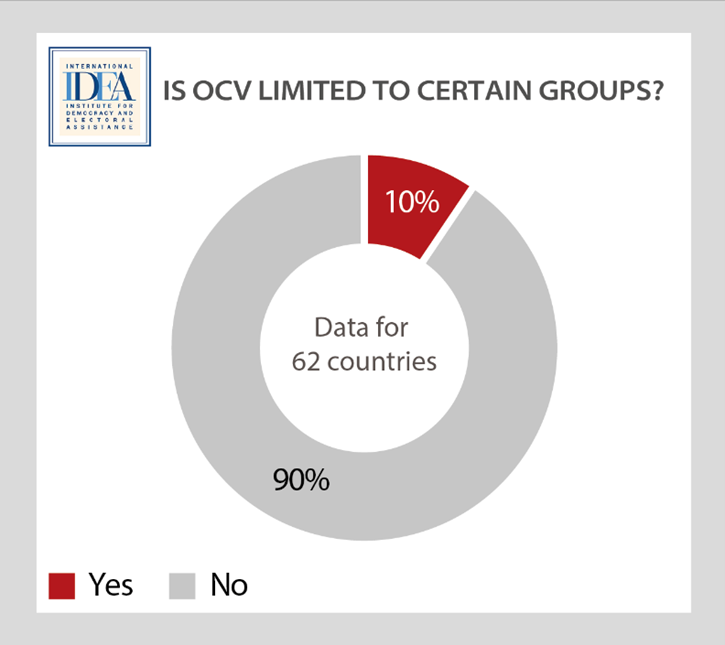 |
Figure 2: Is OCV limited to certain groups? Figure 2 shows that out-of-country voting is limited to certain groups only in 10% of the countries researched. In these countries, OCV is restricted to civil servants (6 countries), students (5 countries), and military (2 countries). This shows that a vast majority of countries surveyed acknowledge the right of enfranchisement for all citizens living abroad. |
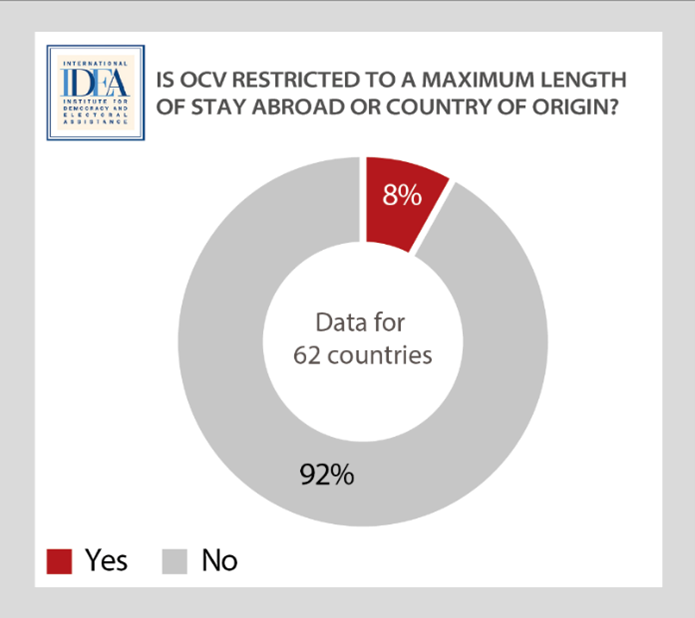 |
Figure 3: Is OCV restricted to a maximum length of stay abroad or country of origin? Results indicate that the length of stay abroad or in country of origin is a rare restriction nowadays for casting vote from abroad. As shown in the Figure 3, only 8% countries impose such restrictions. Most countries surveyed regard the right to vote remains as long as the person remains a citizen of the country.
Details of restrictions are:
|
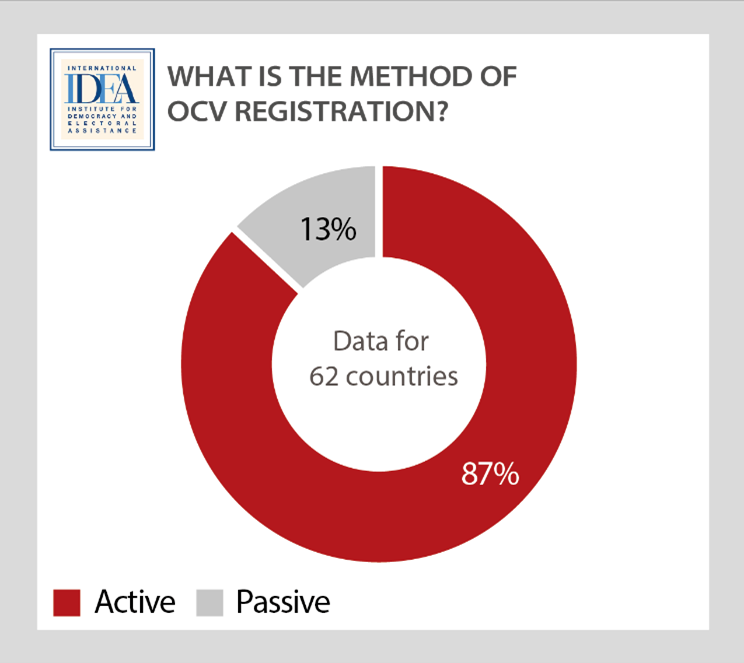 |
Figure 4: What is the method of OCV registration? Results show that in 87% of countries, OCV registration method is active, which means that voters abroad have to take action in order to get registered (Figure 4). Only in 11% of countries OCV registration is passive and voters do not have to take action in order to register to vote from abroad. The voter lists in countries with passive method are generally created either using the information available in the embassies or EMB provides the voter lists to the embassies abroad |
Figure 5: If ACTIVE registration, is the register permanent or does it require re-registration or confirmation by the voter for each election?
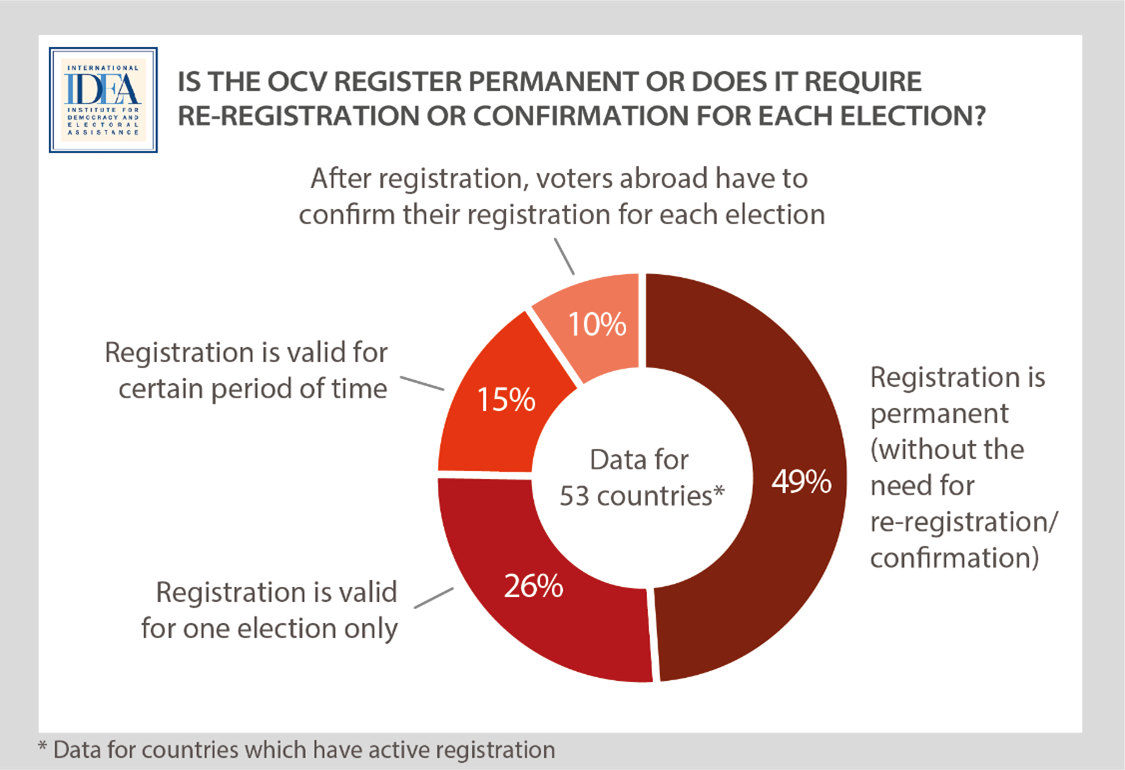
Among those countries which require active registration abroad, in almost half of the countries (49%) OCV registration is permanent (Figure 5). In a quarter of countries (26%), OCV registration is valid for one election only. In 15% of countries, OCV registration is valid for certain period of time, and in 10% of countries, registered voters have to confirm their registration for each election.
Figure 6: If ACTIVE registration, what is the OCV registration mechanism?
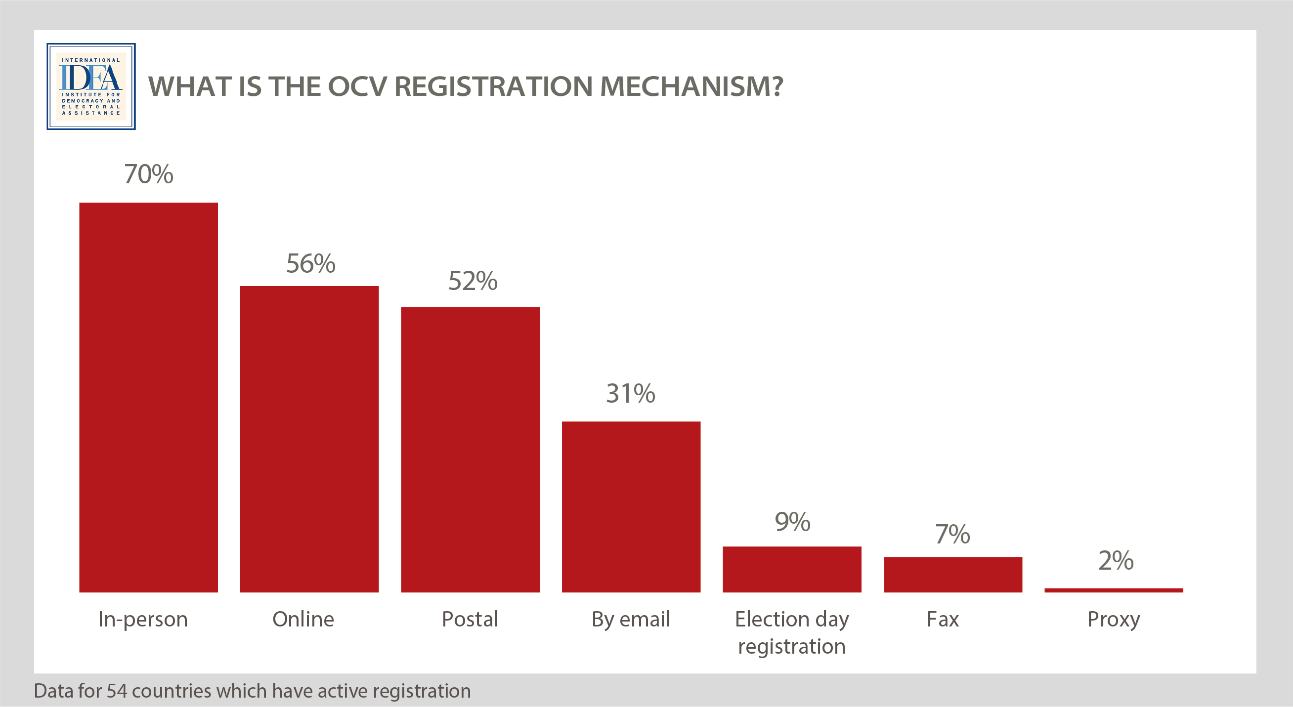
Amongst countries with active registration abroad, in 70% registration can be made in-person (Figure 6), in 56% online registration is possible, in 52% voters can send registration documents by post, and in 31% registration can be made by email. Election day registration, registration by fax and by proxy are much less used methods of voter registration abroad. As with anything in life today, online facilities are growing also for OCV purposes. Given some voters live far from the nearest diplomatic mission, allowing registration remotely is helpful.
Figure 7: What is the voting method abroad?
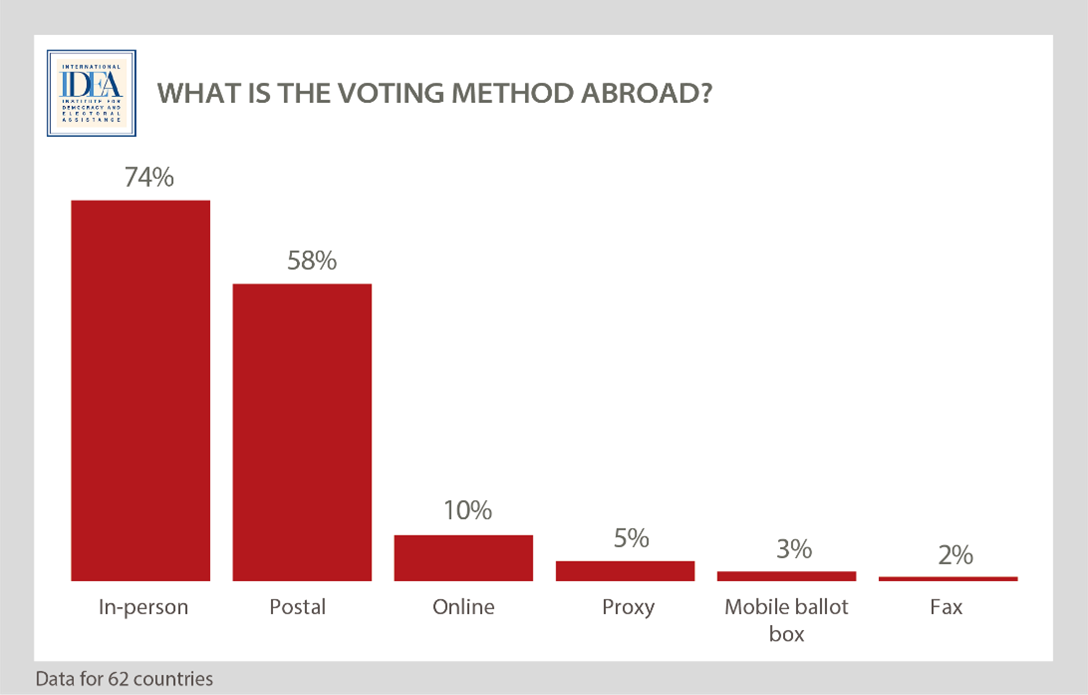
Turning to how out-of-country voters cast their votes, Figure 7 shows voters can vote in-person from abroad in great majority of countries (74%), while postal voting from abroad is available in 58% of countries. Online voting is available only in 10% of countries. Proxy voting, mobile ballot boxes and voting by fax are rarely used practice in OCV. A large majority of countries surveyed still rely on the dependable and robust in-person voting. However, this may not be convenient for voters living far from the polling station and thus, may have an impact on turnout (see Part 2). Postal voting may help remote voters, but it is not without problems and relies on effective postal service, which may not be available in every country.
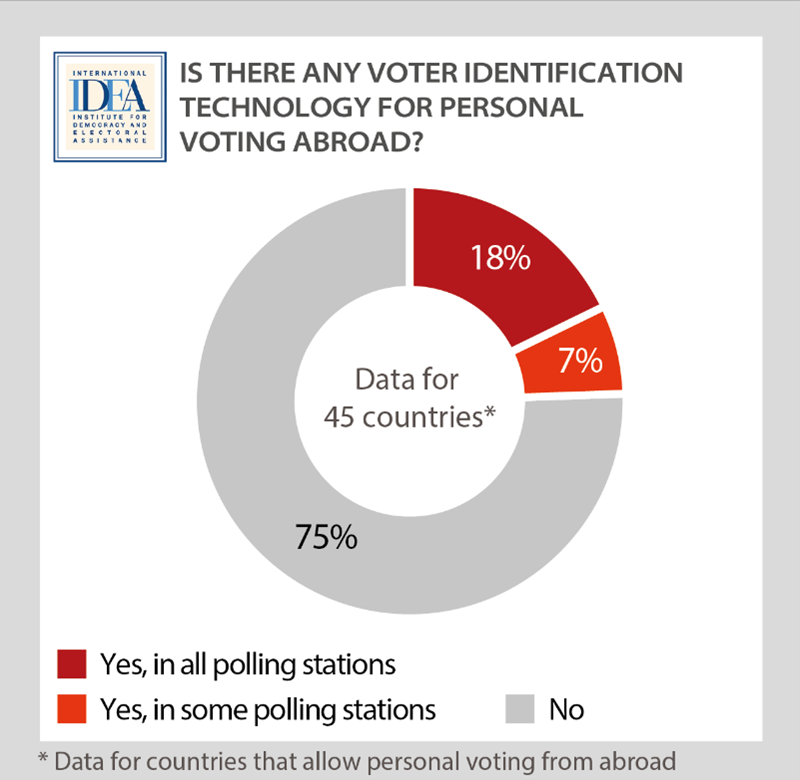 |
Figure 8: Is there any voter identification technology for personal voting abroad? The survey asked respondents about the use of voter identification technology for voting from abroad. The results show that only a quarter of countries covered by the survey have such technologies, and among those countries voter identification technology in all polling stations abroad is most common (Figure 8). The uptake of using technology for identifying voters abroad is clearly still on the low side. |
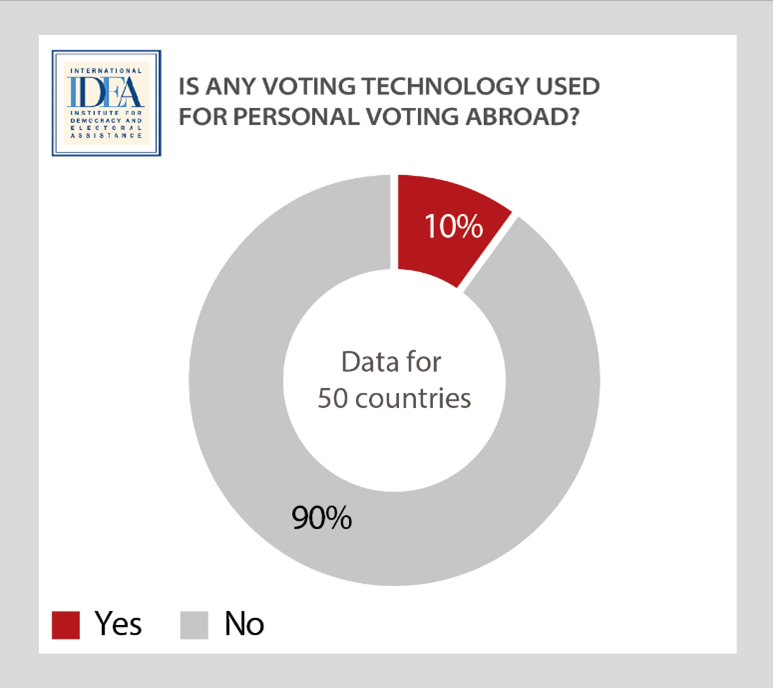 |
Figure 9: Is any voting technology used for PERSONAL voting abroad? The survey found that voting technology for OCV is used only in 10% of countries (Figure 9). The type of voting technology used are as follows:
|
Figure 10: Are there any obstacles that affect voter participation abroad?
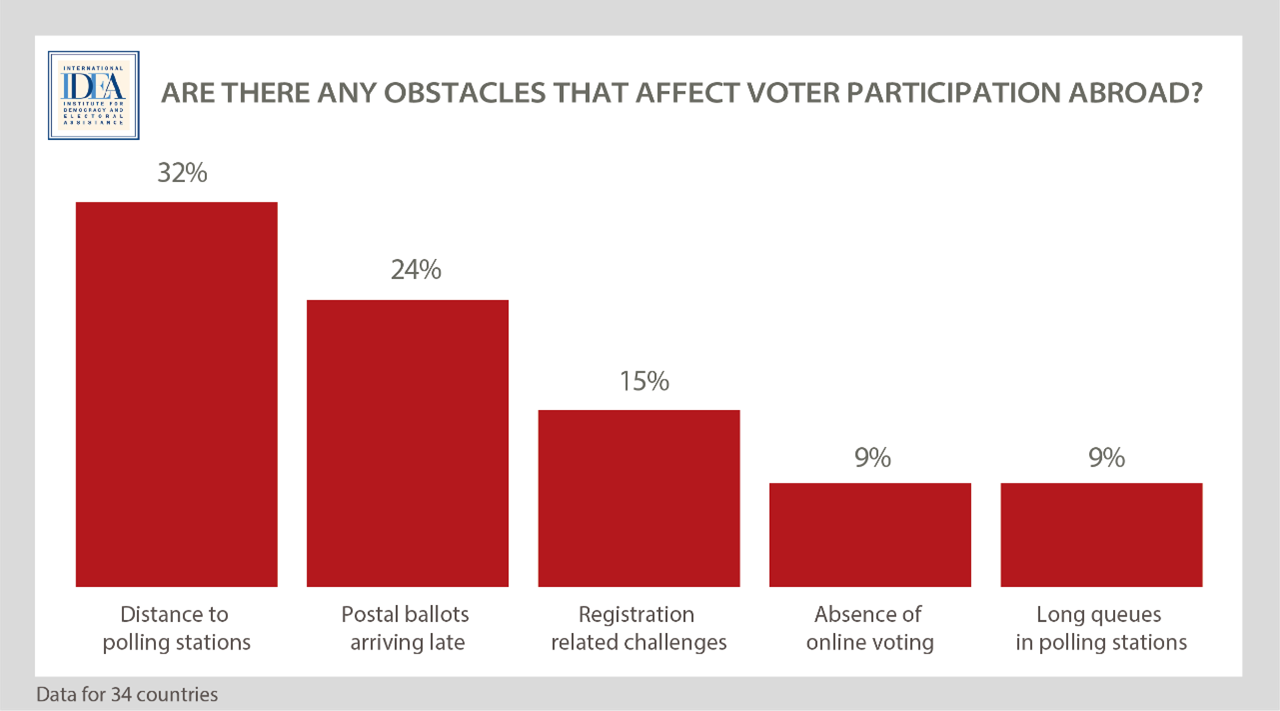
Very often, voters abroad complain about the challenges related to OCV. The survey found that the most common obstacles for out-of-country voting, as indicated by respondents from 34 countries (Figure 10), were distance to polling stations (32%), late arrival of postal ballots (24%) and registration related challenges (15%). Only 9% of respondents complained about the absence of online voting and long queues in polling stations abroad. Distance being the top obstacle shows that voters abroad tend to live far from any in-person voting stations. The fact that 24% expressed an postal ballot problem shows a good proportion of voters rely on postal voting. As such, countries need to think of ways to improve OCV, potentially through technological means and finding alternatives to postal voting. This is the reason for International IDEA’s study.
PART 2: OCV TURNOUT
This part explores the findings related to the rates of voter registration and turnout in OCV.
Figure 11: Share of OCV registration in overall registration
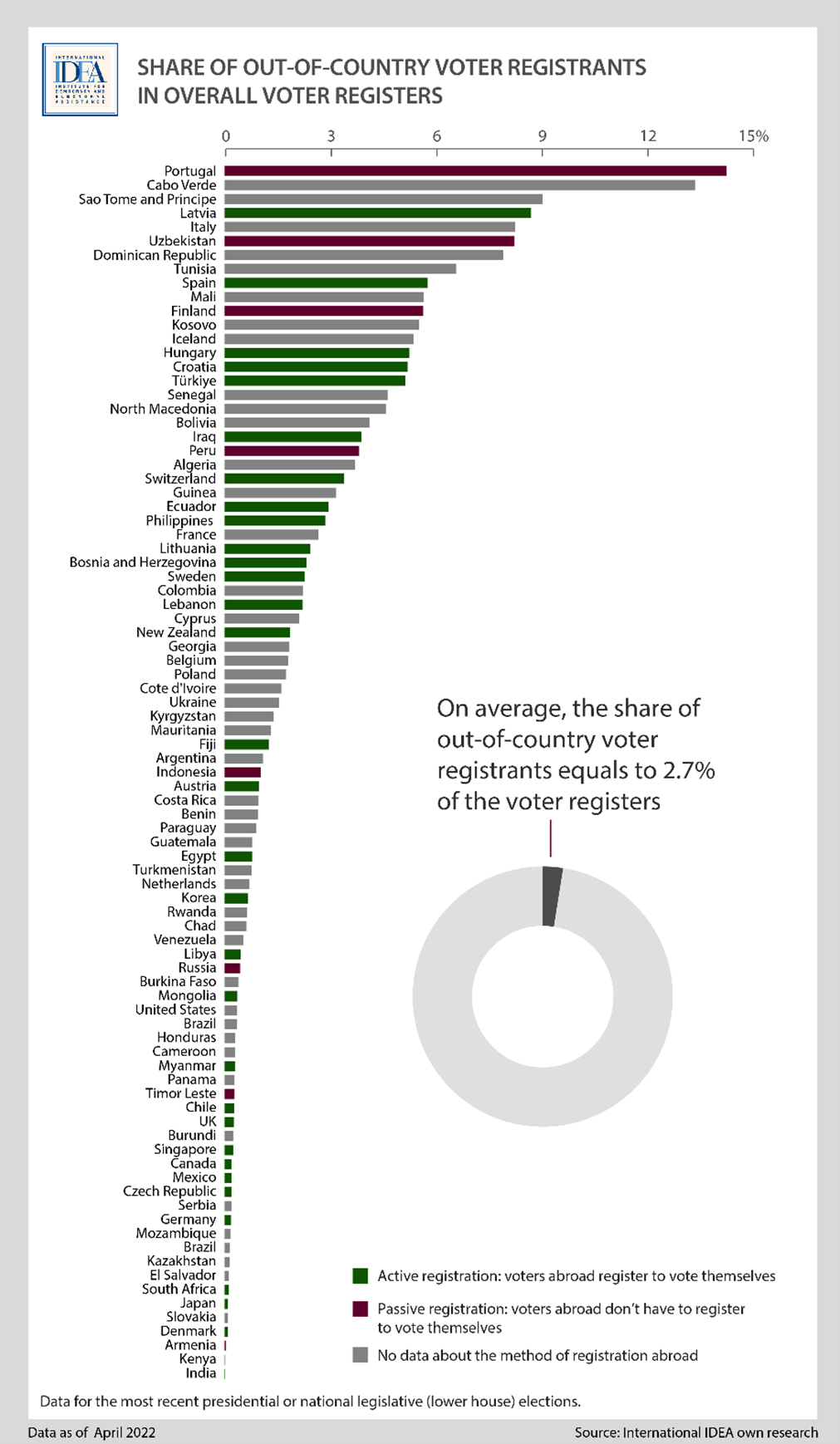
As Figure 11 shows, the number of registered voters abroad is a great minority of registered voters overall. Only in 8 countries more than 6% of the registered voters are abroad. Some countries with a large diaspora such as Italy and Türkiye have a high share of 8.25% and 5.13% registered voters out of country. Others country with a large diaspora, such as Mexico with 0.20% have a low share of the electorate respectively are registered abroad. This demonstrates the significant impact registration and voting arrangements have on this share.
Figure 12: OCV turnout vs ratio of OCV registration
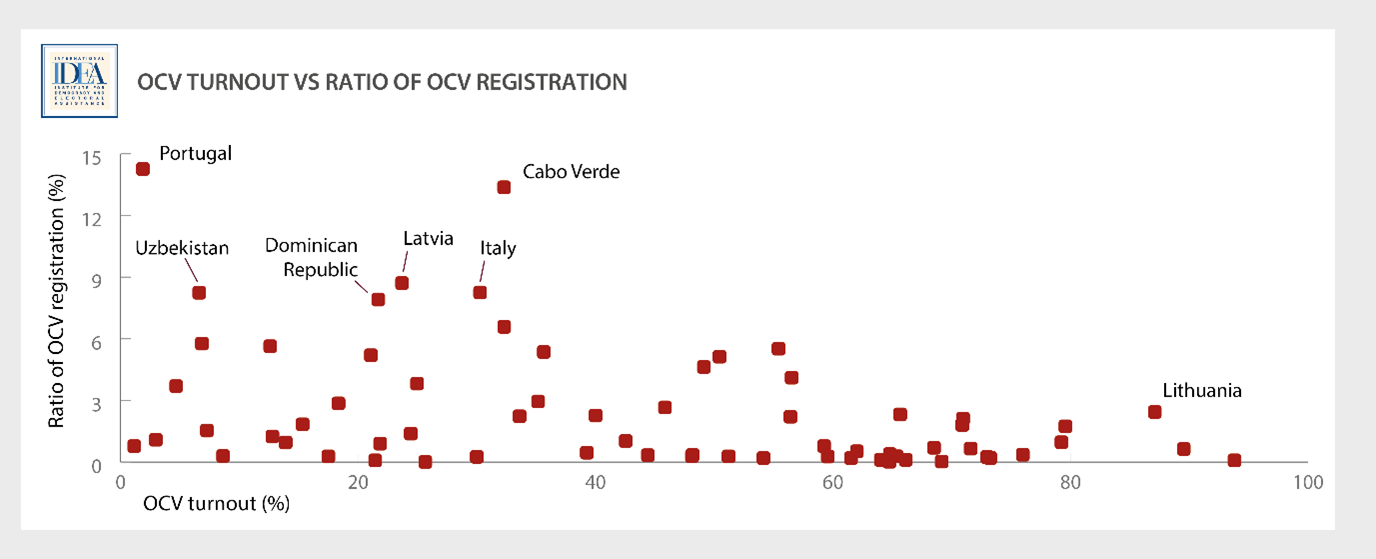
Figure 12 compares OCV turnout with OCV registration rates on the overall voter register. From this at least three patterns seem to emerge:
- Countries with high OCV turnout, like Lithuania, tend to be countries with a low proportion of registered voters overseas. Countries with 60% OCV turnout or higher all have 3% or less out-of-country voters.
- In countries where the ratio of OCV registrants is very high, such as in Portugal, Cabo Verde, Uzbekistan, Dominican Republic, Latvia and Italy OCV turnout low and remains under 40%
- In countries where the ratio of OCV registrants is low, turnout varies greatly from less to 10% to almost 100%
The explanation of this patterns is likely complex. Countries with high registration rates may have simpler registration procedures: This in turn may lead to more outdated or possibly inflated registers. On the flip side, where registration is more difficult and restrictive, those citizens making the effort to register may also be likely to vote once they manage to get registered.
Figure 13: OCV turnout compared to overall turnout
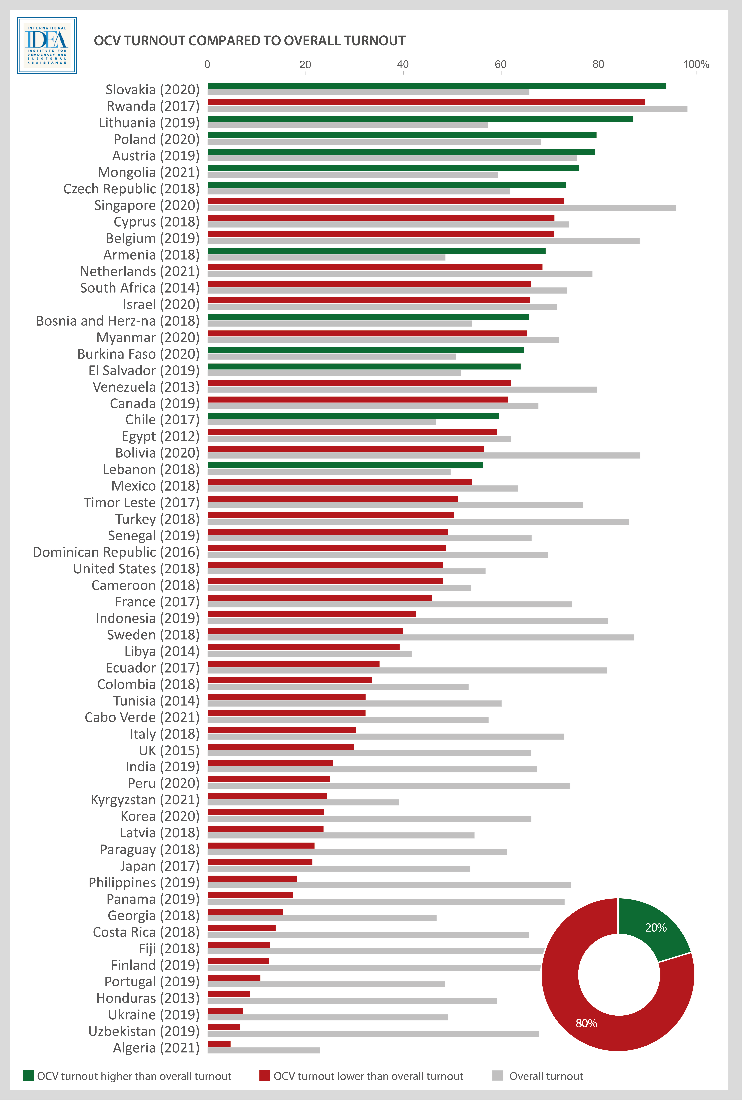
Figure 13 offers proponents of citizens living abroad’s enfranchisement some food for thought. OCV turnout (in green and red) tends to be lower than that of the national overall turnout (in grey). Towards the bottom of the graph are examples of some very big the differences.
Figure 14: Share of OCV total vote in overall total vote
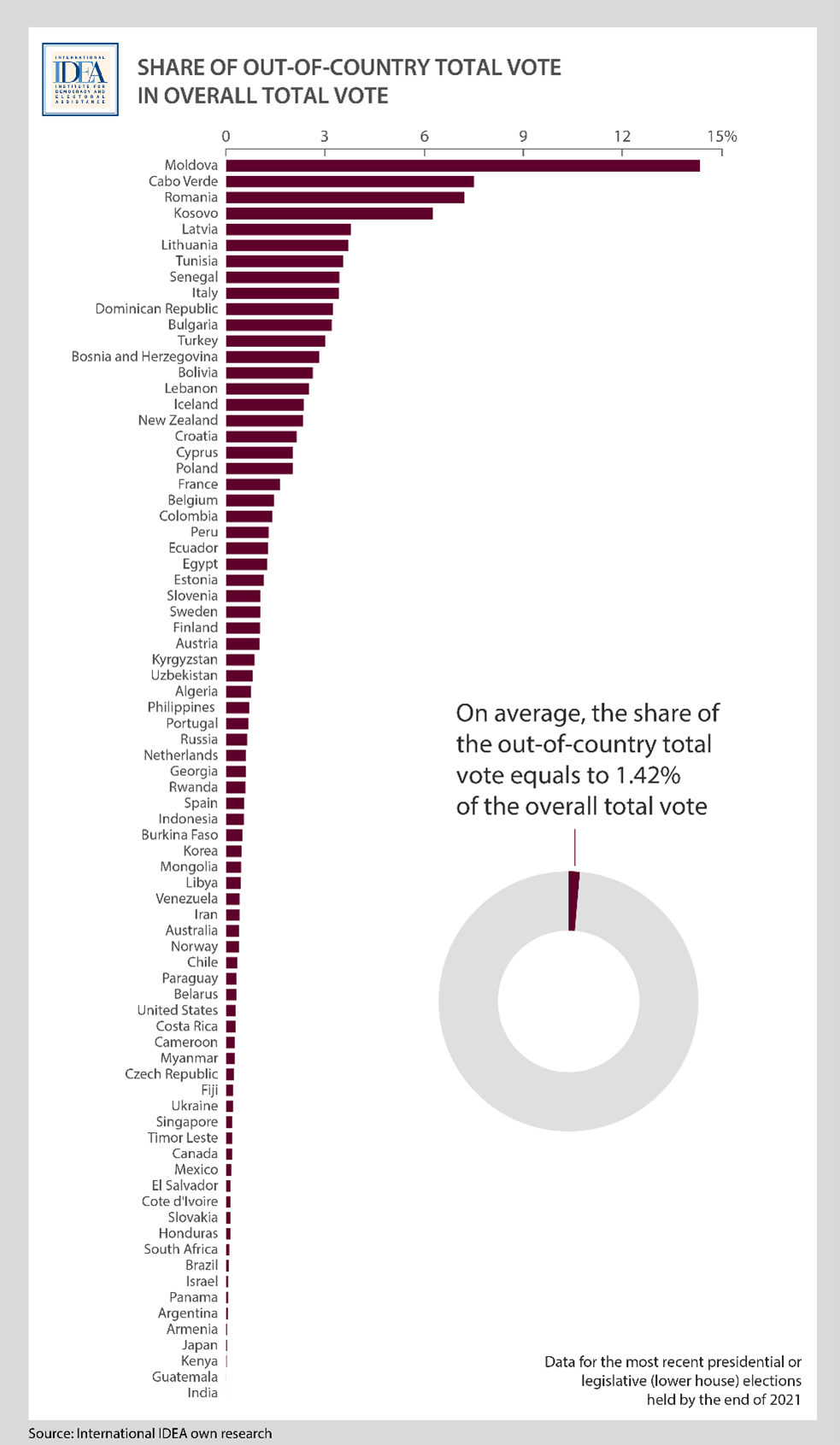
Figure 14 shows how many of the cast votes ultimately come from voters abroad. This rate is highest in some – but not all - the countries with a large diaspora, especially in Moldova, Cabo Verde, Romania and Kosovo where more than 6% of the vote is cast abroad.
In the vast majority of countries, the share of out of country voters is less than 3%, often even less than 1%. This indicates that any concerns about votes from abroad disproportionately influencing the overall election result are not warranted in most of the countries covered by this data.
PART 3: THE IMPACT OF OCV PRACTICES ON OCV PARTICIPATION RATES
This part presents the findings about how OCV practices discussed in Part 1 affect the rates of out-of-country voter registration and voter turnout. Readers should note that due to missing data for some data categories, the number of countries in the figures differ.
Figure 15: Active vs passive voter registration and the rates of OCV registration and turnout
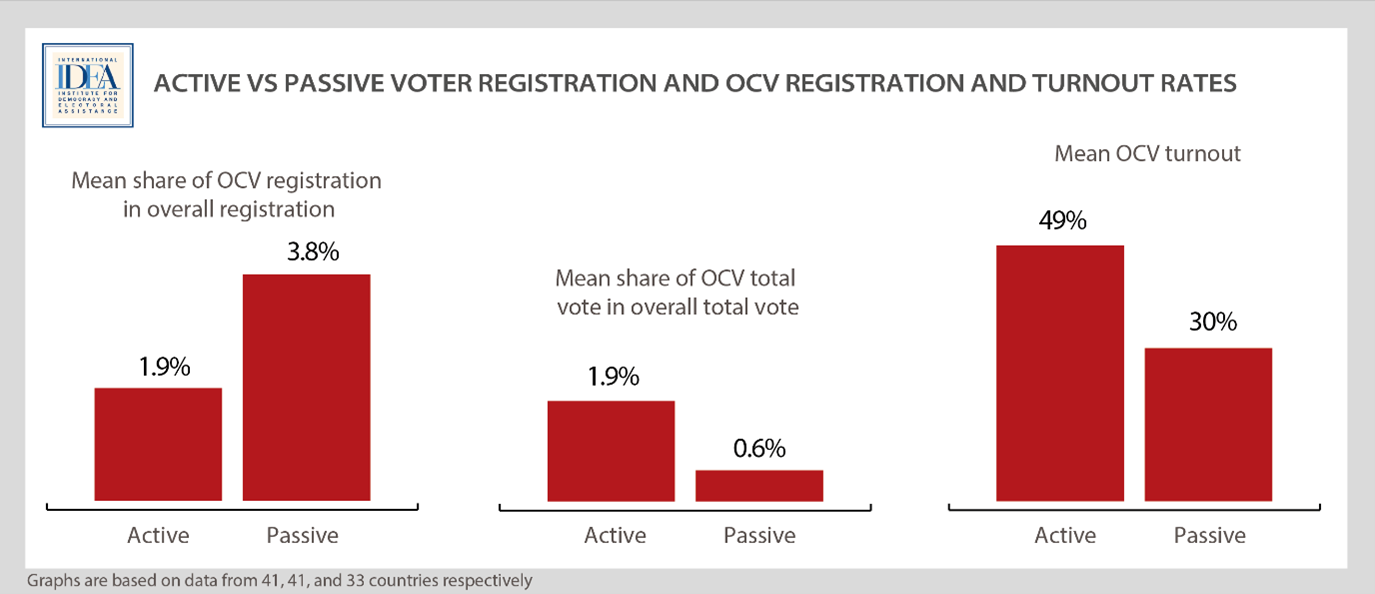
Figure 15 indicates that passive registration increases registration rates , but turnout decreases. This may indicate a bloated OCV registry. Countries with passive registration need to conduct periodic checks/audits to test the accuracy level of their registries.
Figure 16: Channels of voter registration and OCV registration and turnout rates
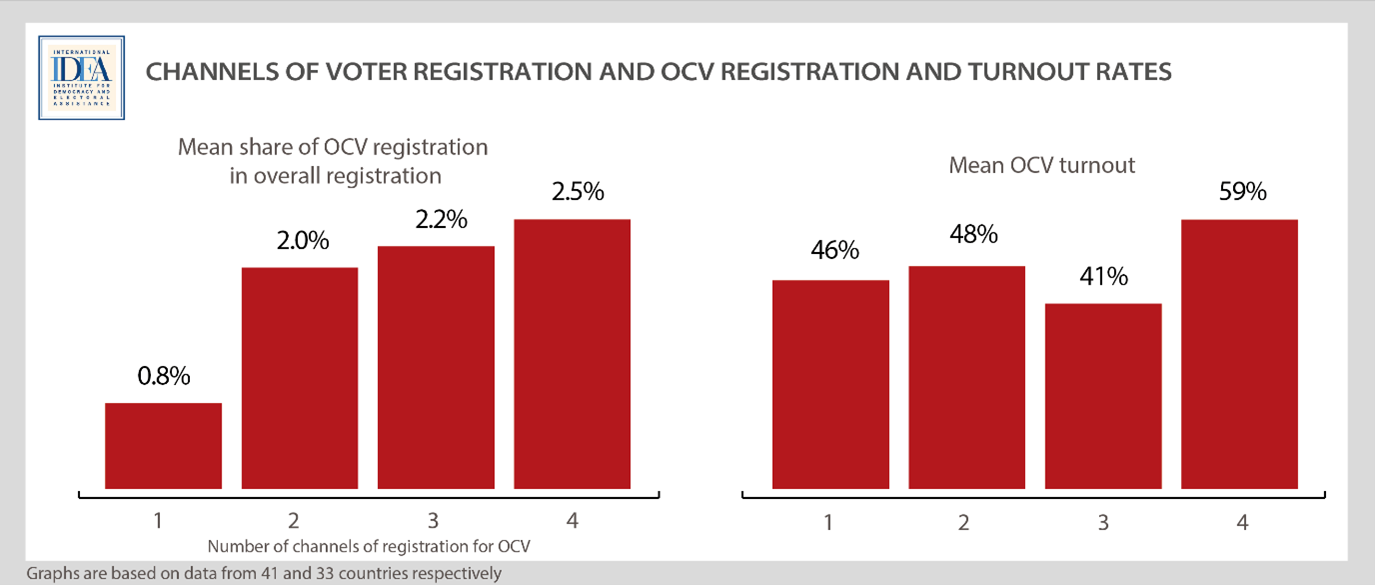
The more registration channels, the higher the registration rate and turnout increases with that (Figure 16). This indicates that investing in more registration channels leads to higher participation abroad.
Figure 17: Registration by post and rates of OCV registration and turnout
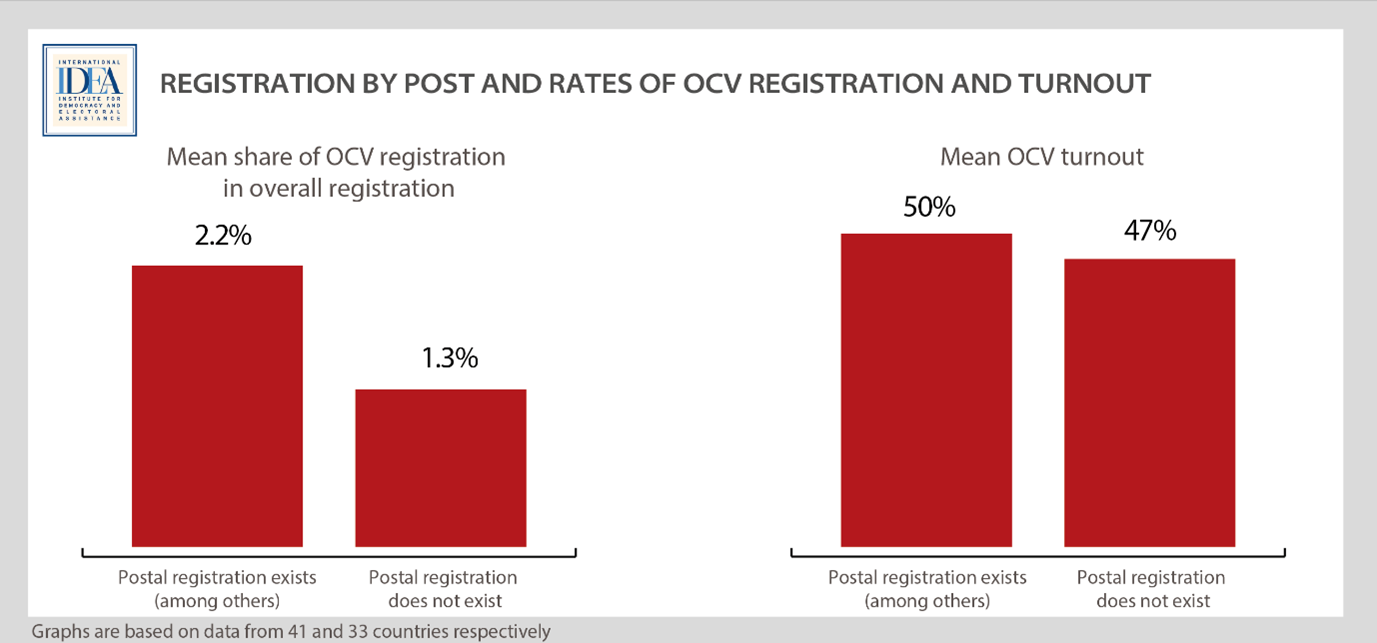
Registration by post has positive impact on registration , but turnout amongst those who register does not change much (Figure 17). As per the observation made on Figure 10 above, voters abroad tend to live far from the nearest in-person polling station. Therefore, means that will enable them to vote remotely, such as postal voting, online voting and telephone-assisted voting have a positive impact on turnout.
Figure 18: Online registration and rate of OCV registration and turnout
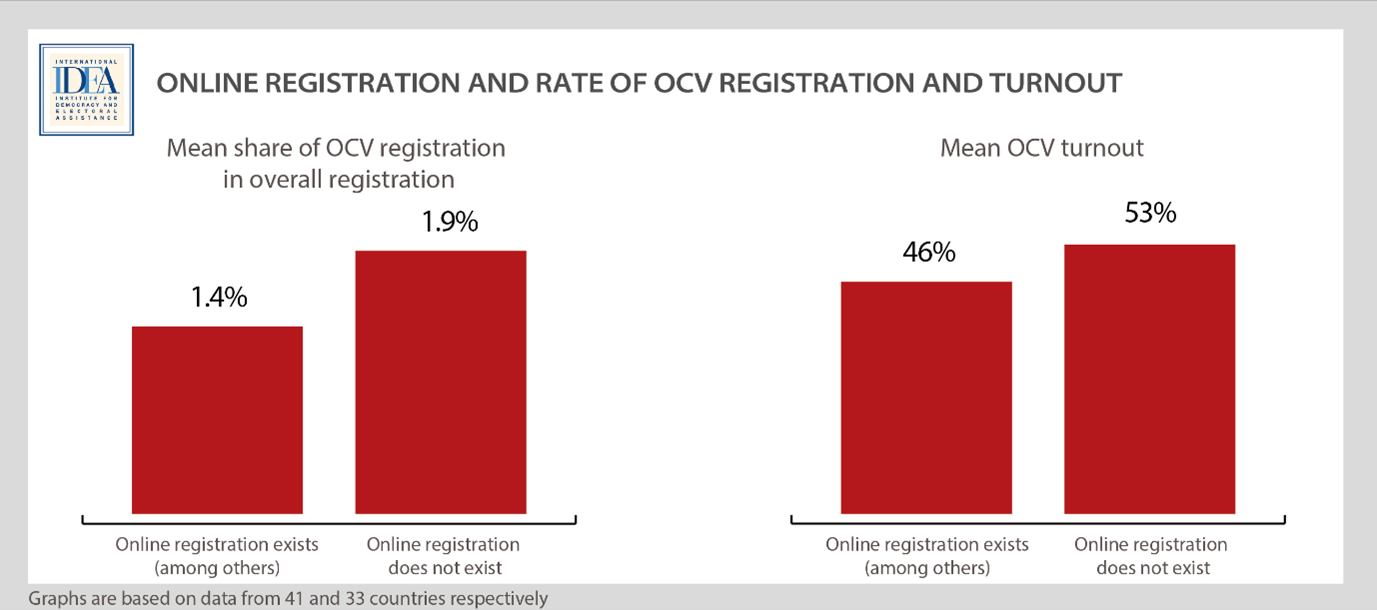
Online registration does not necessarily result in a higher registration rate out of country compared to in country voters. Figure 18 actually show that registration rates are lower where online registration is offered. At the same time, in countries with online registration OCV turnout is on average 9 percentage points higher.
Figure 19: Online voting and OCV turnout
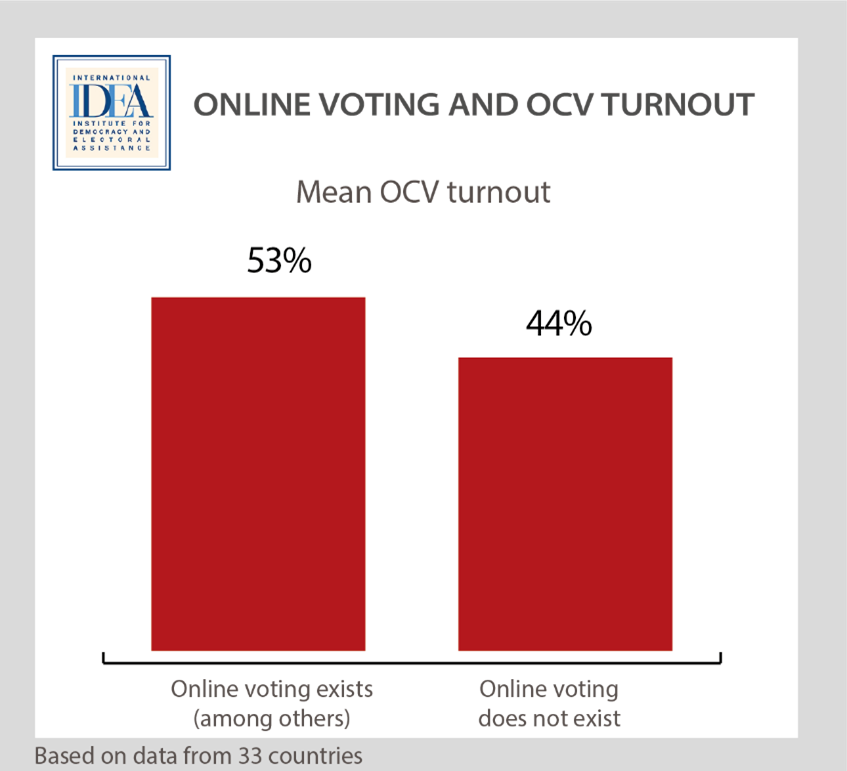
Survey data indicates that OCV turnout is higher where online voting from abroad is possible. However, the sample size here is very small, the dataset only has OCV turnout data for 3 countries that allow online voting from abroad: Armenia, Ecuador and Mexico. Unfortunately OCV turnout data for Estonia, France and Switzerland – 3 more countries that allow online voting from abroad – could not be obtained.
PART 4: COMPARING ASIA & THE PACIFIC REGION WITH THE REST OF THE WORLD
This contains a regional comparative analyses where data of Asia and the Pacific (AP) countries are compared with that of the rest of the world.
Figure 20: Is OCV limited to certain groups?
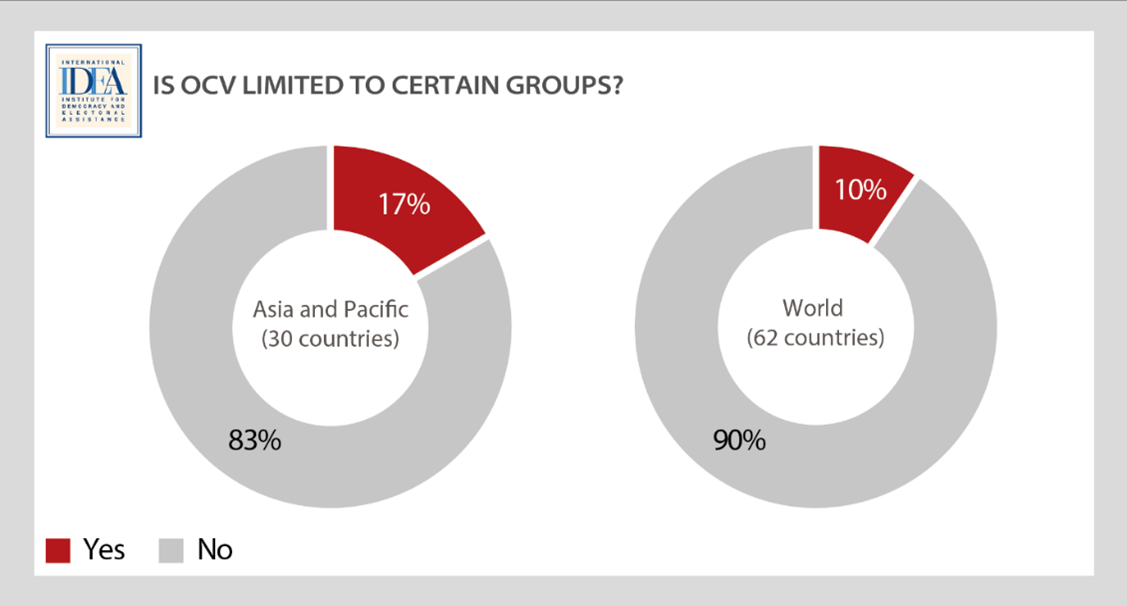
The AP region is more prominent in terms of limiting OCV to certain groups of voters only (Figure 20). Notable examples are India and Malaysia where for most citizens living abroad, OCV means having to come home to vote.
Interestingly, however, only 1 AP country (New Zealand) restrict OCV based on time spent abroad.
Figure 21: Is OCV restricted to a maximum length of stay abroad or country of origin?
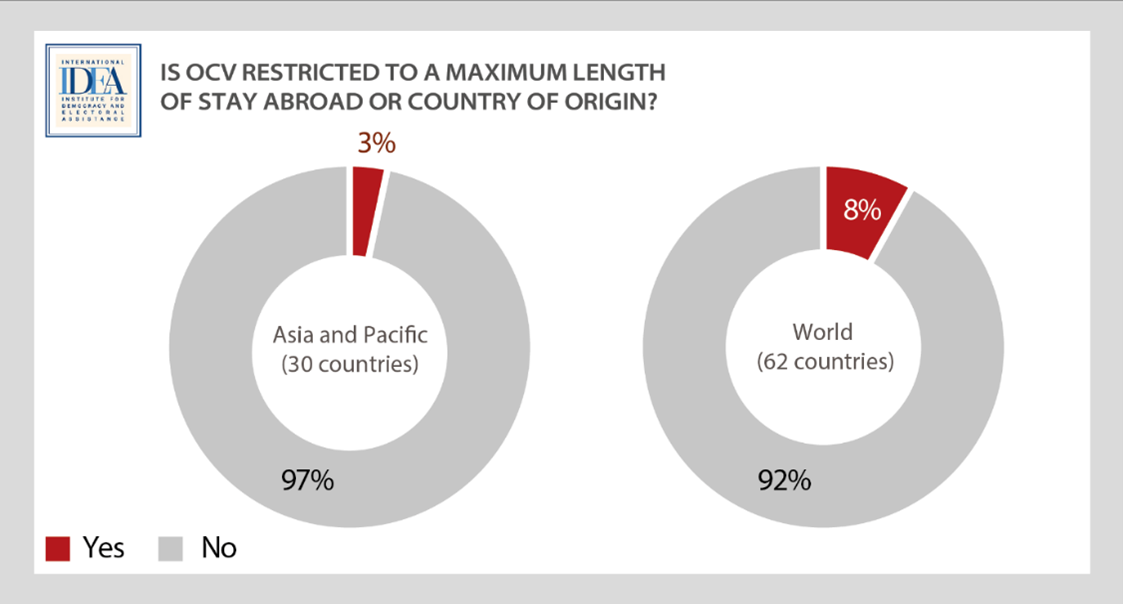
Like the rest of the world, a vast majority (87%) of AP countries adopt active OCV registration, which means voters have to actively get themselves on the voters’ roll.
Figure 22: What is the method of OCV registration?
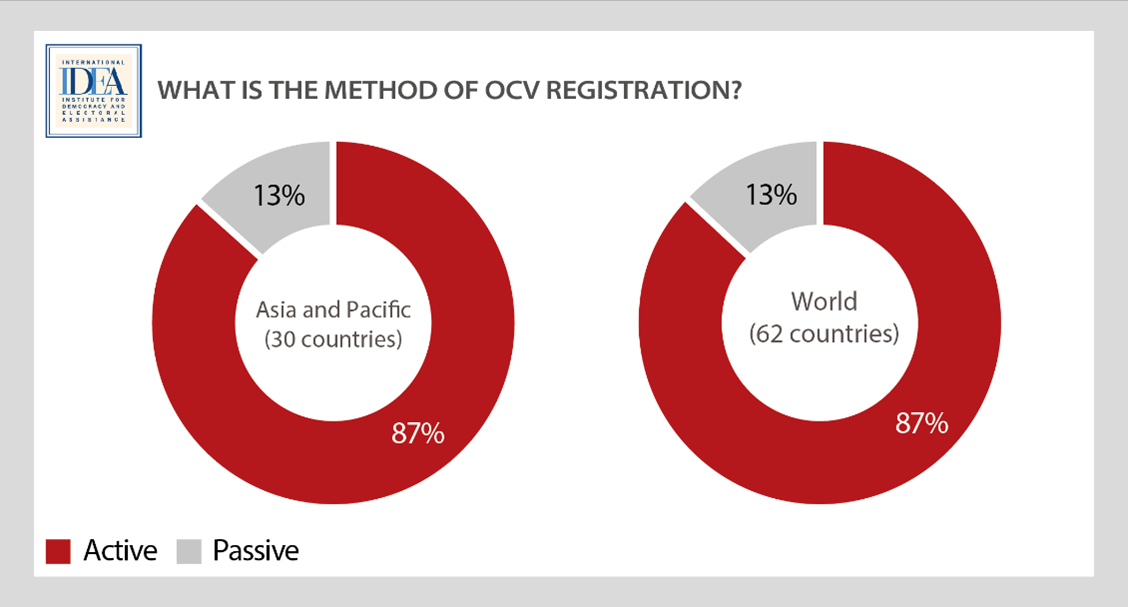
Figure 23: If ACTIVE registration, is the register permanent or does it require re-registration or confirmation by the voter for each election?
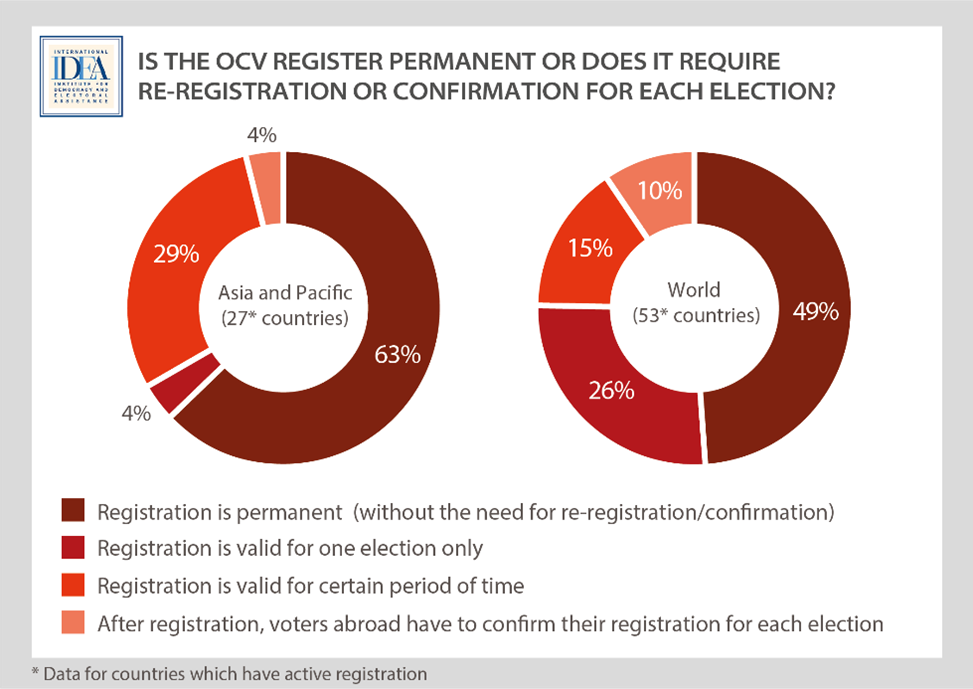
The picture is however more mixed once we delve into active registration system deeper. While like the rest of the world most AP countries have permanent registration of voters, i.e. voters are not required to re-register or reconfirm their residential status, more AP countries prefer the registration to be valid for a certain period of time rather than for one election only that the rest of the world prefer better (Figure 23).
Figure 24: If ACTIVE registration, what is the OCV registration mechanism?
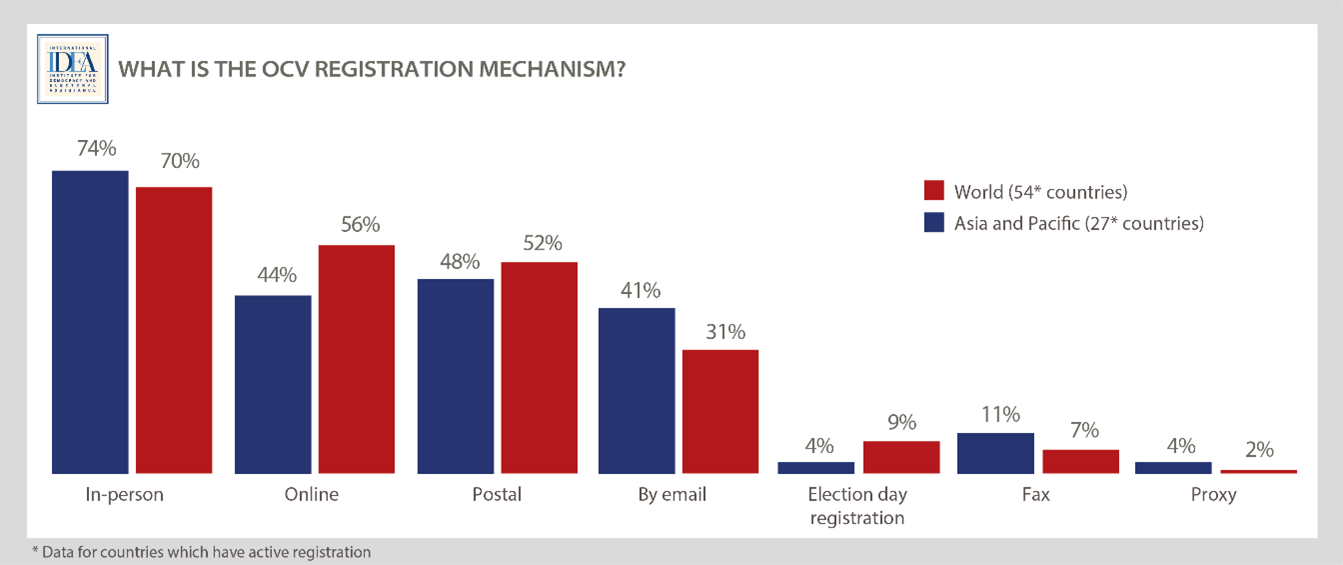
As Figure 24 shows, AP countries are leading the pack in adopting registration by e-mail, which is another friendly method for remote voters. OCV is by nature scattered around the world, which locations of diplomatic mission for most countries, except for the United States and maybe the United Kingdom, simply cannot keep up. Therefore, remote-friendly methods such as online, postal and email are necessary. While the world is embracing such methods more and more, a vast majority of countries, both in AP region and the rest of the world, also rely on in-person registration, which is costly for both the organisers and the voters.
Figure 25: Technologies for OCV voter registration (%)
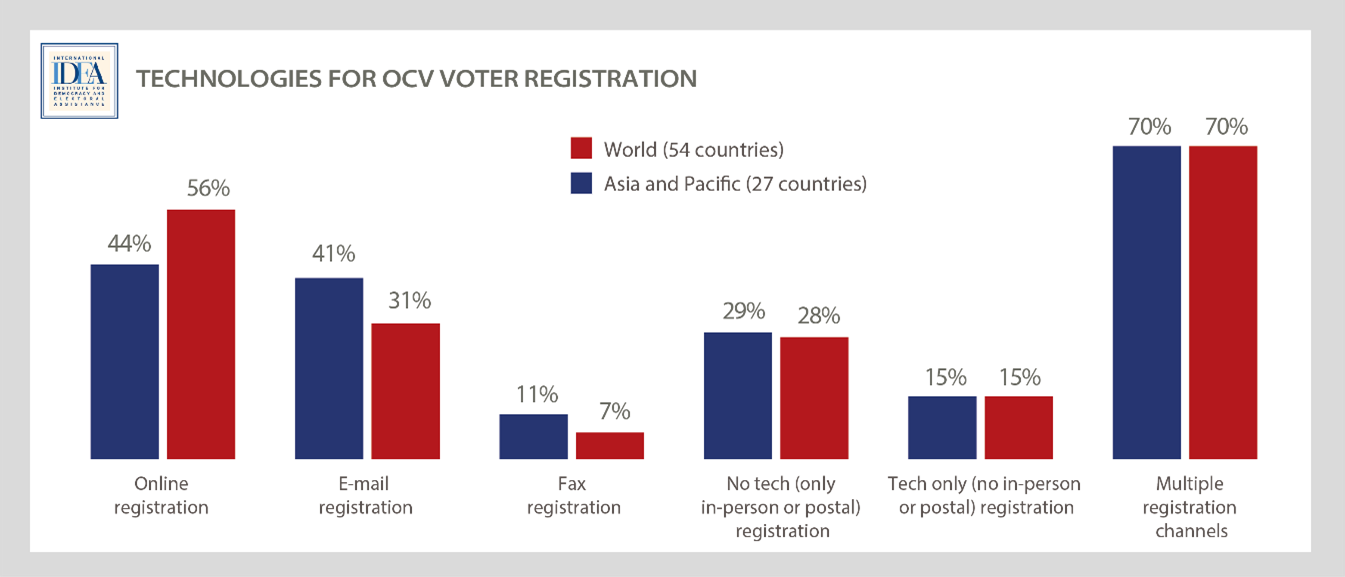
A deeper look into the use of technology shows technological tools are most often used in combination with non-technological methods (Figure 25). This as Figure 16 above shows, improves the rate of registration and turnout.
Figure 26: What is the voting method abroad?
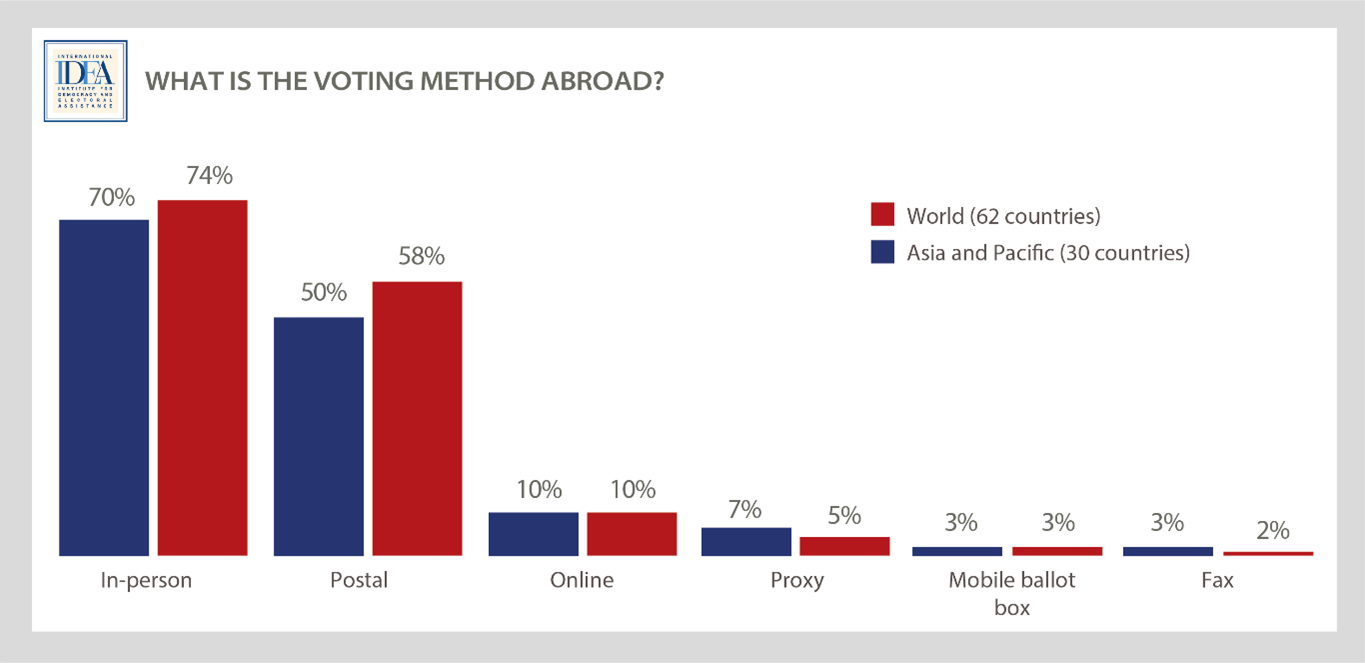
Figure 27: Technologies for OCV voting (%)
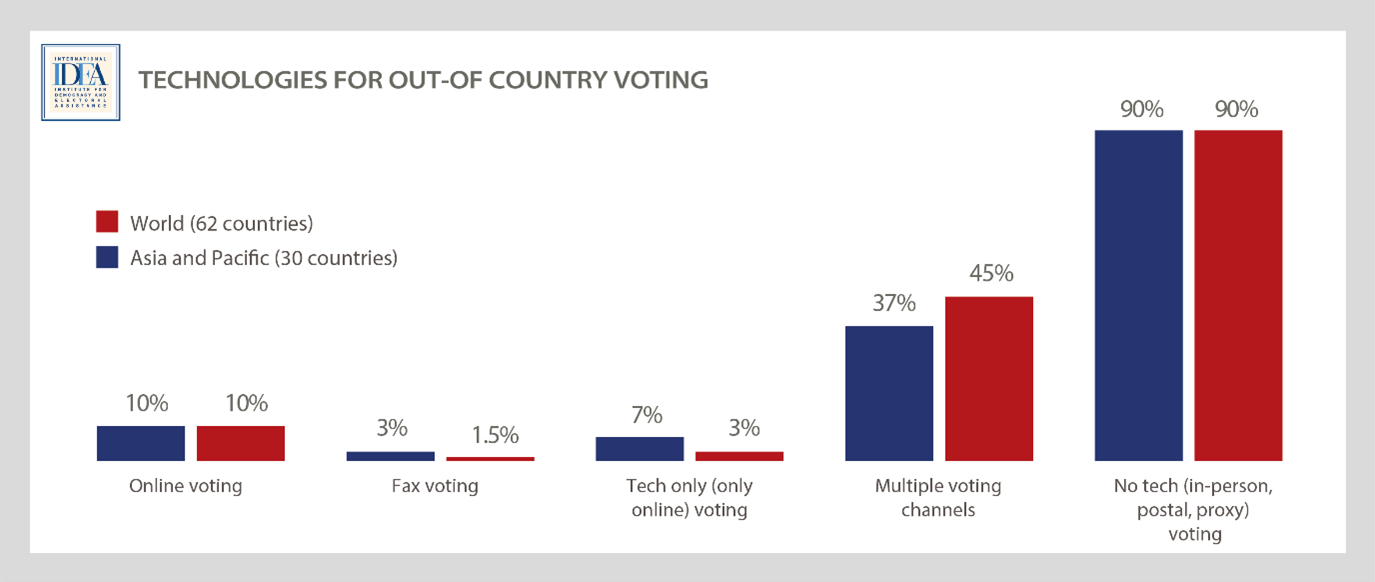
Turning to voting methods, in-person and postal voting dominate by far (Figure 26). This is not only costly, but may also be the culprit of low voter turnout. Closer inspection of this phenomenon is necessary. The use of voting technology for OCV is still quite nascent globally speaking (Figure 27), but this is expected to rise as the challenges and needs of out-of-country voters are better understood by policy makers.
Technology is still rarely used for both identifying voters and casting votes when voting in-person (Figure 28 & 29), but this is a space to watch as more technology uptake occurs in electoral processes more broadly. Most prominent technology used at present are electronic poll books and ballot scanners/voting machines for identification of voters and casting votes respectively (Figure 30).
Figure 28: Is there any voter identification technology for personal voting abroad?
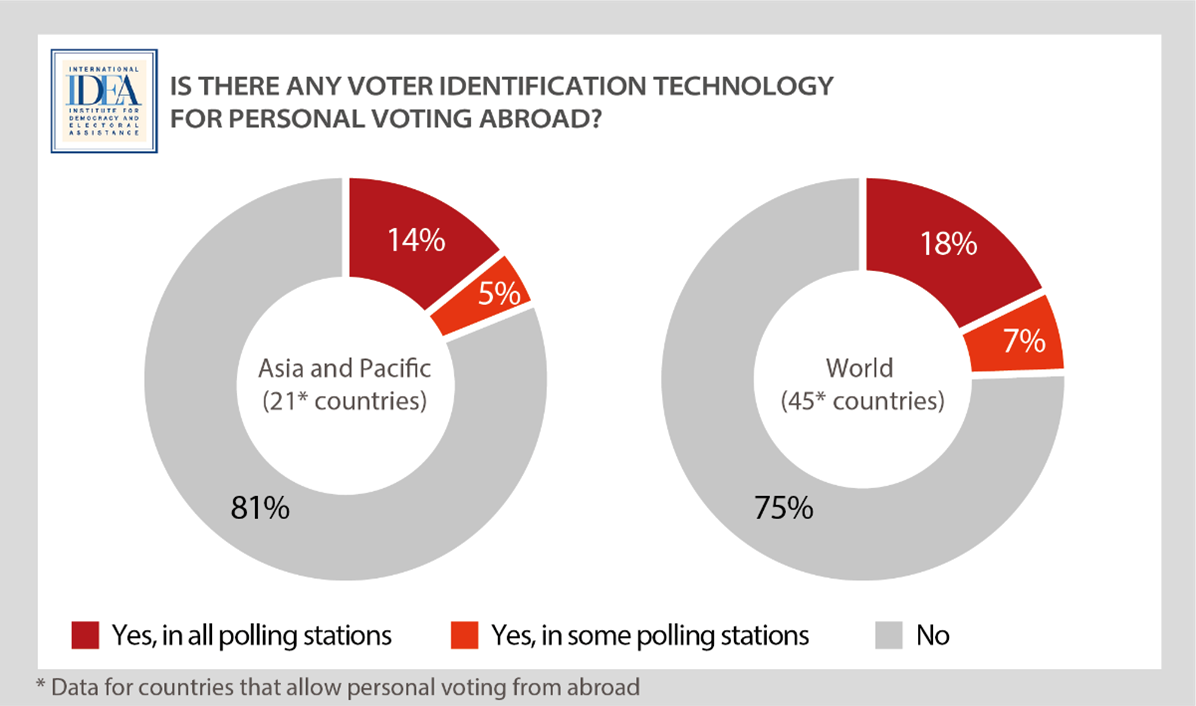
Figure 29: Is any voting technology used for PERSONAL voting abroad?
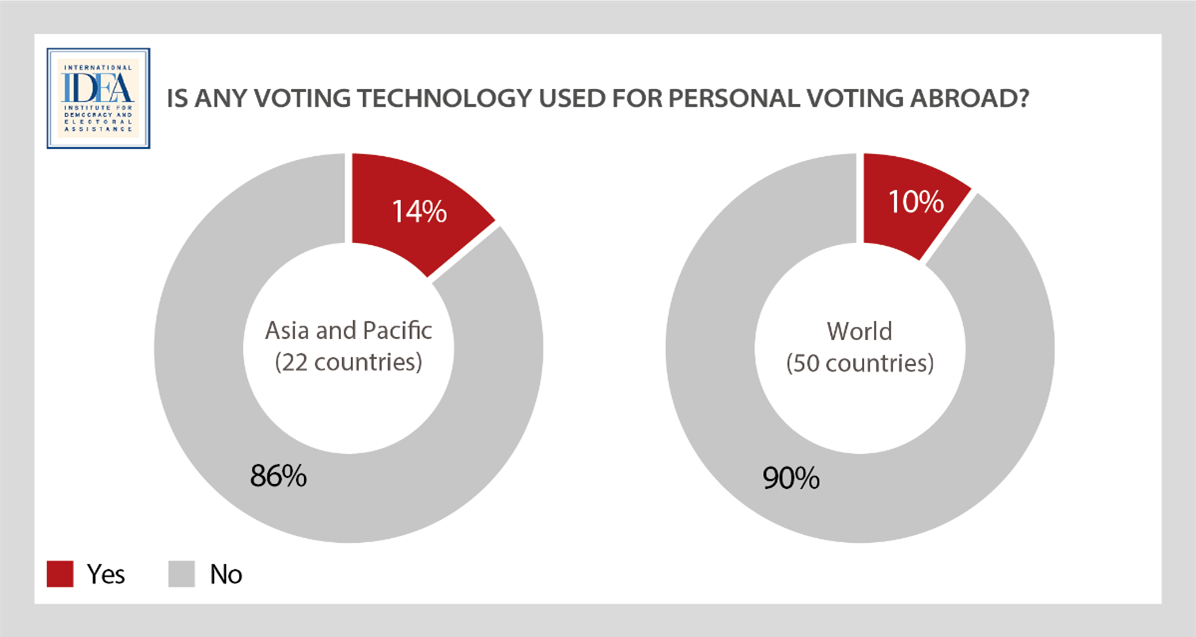
Figure 30: Technologies for OCV in-person voting (%)
